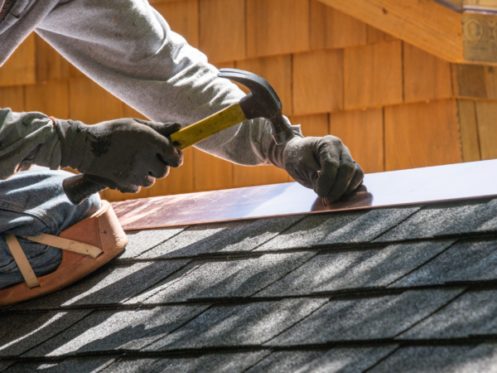The pitch or slope of the roof on your Corpus Christi home was chosen for far more than its aesthetics. For instance, in areas with heavy snow and heavy snow loads, flat roofs are rarely installed. Designing and installing roofs that have sufficient slopes encourages the shedding of ice, sleet, and other forms of precipitation. It also prevents roofs from collapsing and sustaining water damage. Read on to find out more about why roof pitch is so important.
What Is Roof Pitch?
Roof pitch indicates how steep a roof is. Pitch refers to the angle of a roof’s slope. It can be calculated by the number of inches a roof raises vertically for every foot that it travels horizontally. This calculation is often referred to as “rise over run”. A roof that rises 5 full inches per every foot or 12 inches of horizontal space has a pitch of 5/12. A severely sloped roof might have a pitch of 12/12 while a nearly flat roof may have a pitch of just 2/12 or less.
How Environmental Conditions Determine the Ideal Roof Slope
Projected snow and ice loads are two important considerations that architects, engineers, and roofers make when determining the ideal roof pitch for any standing structure. Steeper slopes make it easier for roofs to shed these heavy, cold-weather accumulations. Slightly steep roofs must bear this weight for longer periods. With a minimal slope, the risk of heavy snow accumulations must be minimal.
Calculations are also made to ensure that if major build-ups do occur, roofing systems can hold up long enough for these build-ups to melt and migrate downwards. Based upon the angle of a roof’s pitch, this should be before the maximum snow load for the roof is reached. Other factors used to determine the ideal slope for any roofed structure include the layout of the building, the attached drainage system, and the roofing materials used.
When Is a High Roof Pitch the Right Choice?
Steep roof slopes are common in areas that get considerable snowfall, freezing rain, and hail. Moderately steep roofs are common in regions that get lots of rain but less freezing precipitation. However, even when excessive precipitation does not necessitate the use of a steeper slope, there are still benefits that can be gained by choosing a high roof pitch. For instance, roofs with a high pitch:
- Tend to sustain less moisture-related wear and last longer
- Create extra usable space at the topmost portion of the building interior
- Provide the opportunity to install additional loft insulation
Steeply sloped roofs can also be aesthetically beautiful when paired with certain architectural elements. Thus, it’s possible to find roofs with steep slopes throughout the nation irrespective of local precipitation averages.
What Are the Benefits of Having a Flat Roof?
Flat roofs aren’t incredibly common in residential developments. You’re more likely to see flat roofs on large commercial warehouses or industrial facilities. However, when climate conditions are permitting, some homes may have slopes as low as 2/12 or even 1/12. Flat roofs are cheaper to install than sloped roofs given that they require both less labor and fewer materials. They are also easier to maintain. After all, the steeper that a roof is, the more difficult it is to access, traverse, and work on.
If properly installed and adequately reinforced, flat roofs also make it possible for homeowners to continue building upwards as they see fit. For instance, an in-law unit, enclosed garden room, or patio can be installed on a flat roof. To provide this level of adaptability, an increasing number of architects in relatively low-precipitation areas are currently opting to design homes with flat roofs.
In general, flat roofs do not last as long as sloped roofs. The moisture that these structures are exposed to tends to remain in place until it either evaporates, gets blown away, or is moved by another outside force. When building their own homes, sheds, tiny homes, or cabins, many do-it-yourself (DIY) enthusiasts are capable of installing simple, flat roofs on their own. Notwithstanding this fact, cheaper installation costs and ease of maintenance are offset by the markedly lower lifespans of DIY flat roofs.
Common Roof Pitch Categories
The term “flat roof” is a misnomer. No roof is actually completely flat. For assured safety, durability, and efficacy, even “flat” roofs must have a slope of at least one-half of an inch per every 12 inches of run. Flat roofs are a well-known type of roof pitch, but they are less common in residential real estate than any other pitch type.
Low-slope or low-pitch roofs have a maximum pitch of 4/12. These roofs are typically installed in dry, arid areas that get minimal snowfall and modest amounts of rain. Medium-pitch roofs have a pitch that falls between 5/12 and 9/12, and high-pitch roofs have slopes measuring 9/12 and above.
At Bayfront Roofing and Construction, we’re committed to helping our clients make informed decisions about their roofs. We provide roof installation, roof replacement, and roof maintenance services to residents of Corpus Christi and the surrounding areas. We also offer windstorm certification, mobile home roof repairs, and patio covers. If your roof is in disrepair, call us today to schedule an appointment.
